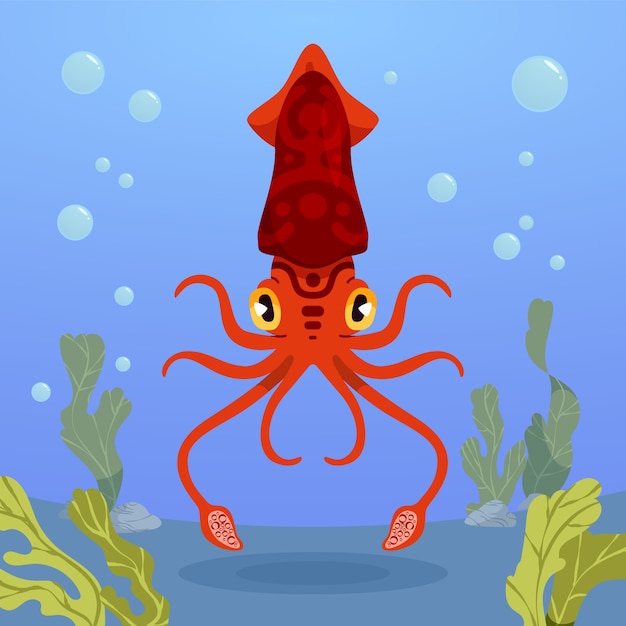

The largest squid ever recorded measured 59 feet in length.
The giant squid has the largest eyes of any known creature.
Squids have three hearts: one main heart and two smaller ones to pump blood to the gills.
Squids can change the color of their skin to communicate with each other and camouflage themselves.
The ink sac of a squid contains black ink, which they release as a defensive mechanism to confuse predators.
Some squid species have bioluminescent organs that allow them to produce light in the dark depths of the ocean.
Male squid have a specialized arm called a hectocotylus that they use to transfer sperm to the female during mating.
The lifespan of most squid species is only about 1-2 years.
Squids are known for their incredible swimming speed, with some species capable of reaching speeds up to 25 miles per hour.
The eyes of the squid are so well-developed that they can see in low light conditions.
Squids are excellent hunters and use their tentacles to catch prey, such as fish and shrimp.
Some squid species have the ability to rapidly change their body shape to mimic other creatures in the ocean.
Squids have a unique feeding mechanism called the radula, which is a tongue-like organ covered in teeth.
The Humboldt squid is known for its aggressive behavior and has been nicknamed the red devil due to its reddish coloration.
Squid populations can fluctuate greatly depending on environmental conditions and prey availability.
Some deep-sea squid species migrate vertically in the water column daily, moving from deep depths to the surface at night to feed.
Squid have a complex nervous system and are highly intelligent creatures.
The giant squid emits a bioluminescent fluid when attacked, providing an escape opportunity by distracting the predator.
In some cultures, squid ink is used as a culinary ingredient, adding a unique flavor and color to dishes.
Squid have a unique reproductive strategy called semelparity, where they reproduce once in their lifetime and then die.
Some squid species have the ability to change the texture of their skin to match their surroundings, enhancing their camouflage.
Squid have a beak-like mouth that they use to rip apart their prey before consuming it.
The vampire squid, despite its name, does not actually feed on blood but instead captures small prey using its tentacles.
Squids communicate with each other using a variety of visual signals, such as changing skin color and pattern.
Squid are important prey for many marine animals, including whales, dolphins, and various fish species.
The colossal squid, a relative of the giant squid, has hooks on its tentacles that it uses to capture prey.
Some squid species have been found to exhibit a behavior known as flashing, where they emit rapid pulses of light to confuse predators.
Squids have a unique jet propulsion system, where they expel water from their bodies to move through the ocean.
Within minutes of hatching, baby squid are capable of swimming and hunting for food.
The market squid is one of the most commercially important species of squid, with a large fishery dedicated to its capture.
Squid have a high ammonia content in their bodies, which helps them stay buoyant in the water column.
The chambered nautilus, a close relative of squid, has a spiral-shaped shell that it uses for protection.
Some squid species have bioluminescent organs on their tentacles, which they wave to attract prey.
Squids have an incredible ability to regenerate lost limbs, allowing them to survive and continue hunting.
The firefly squid, found in the waters of Japan, emits a blue glow during mating season, creating a breathtaking spectacle.
Squid can swim both forwards and backward by reversing the direction of their movement.
Squid are known for their highly developed visual system, which allows them to effectively navigate their environment.
The vampire squid has the ability to expel sticky mucus from its body, creating a cloud-like structure to confuse predators.
Squid ink contains melanin, which is responsible for its dark color and can have potential medical applications.
Some squid species are capable of bioluminescence that creates a vibrant light show in the ocean when disturbed.
Squids have a specialized pen made of strong, flexible material that provides structural support to their body.
The speed at which squid reproduce is one of the fastest among all marine creatures.
Squids are highly adaptable and can be found in various ocean habitats, from shallow coastal regions to the deep sea.
Squids have a keen sense of smell and can detect the scent of prey from a distance.
The mating display of squid involves complex courtship rituals, such as flashing patterns of light and performing acrobatic movements.
Around the world, coffee enthusiasts enjoy Monin coffee concentrate since it is a multipurpose product. Conveniently combining…
The Importance of Choosing the Right Shower for Your Bathroom Renovating your bathroom can be…
Usain Bolt holds the record for the fastest 100-meter sprint in history.Bolt was named Sportsman…
Love is in the air... and it smells suspiciously like chocolate!Roses are red, violets are…
Life's a beach, take a picture and relax.Sun, sand, and salty kisses. That's what beach…
Hungary is home to the largest thermal water cave system in the world.The Rubik's Cube…